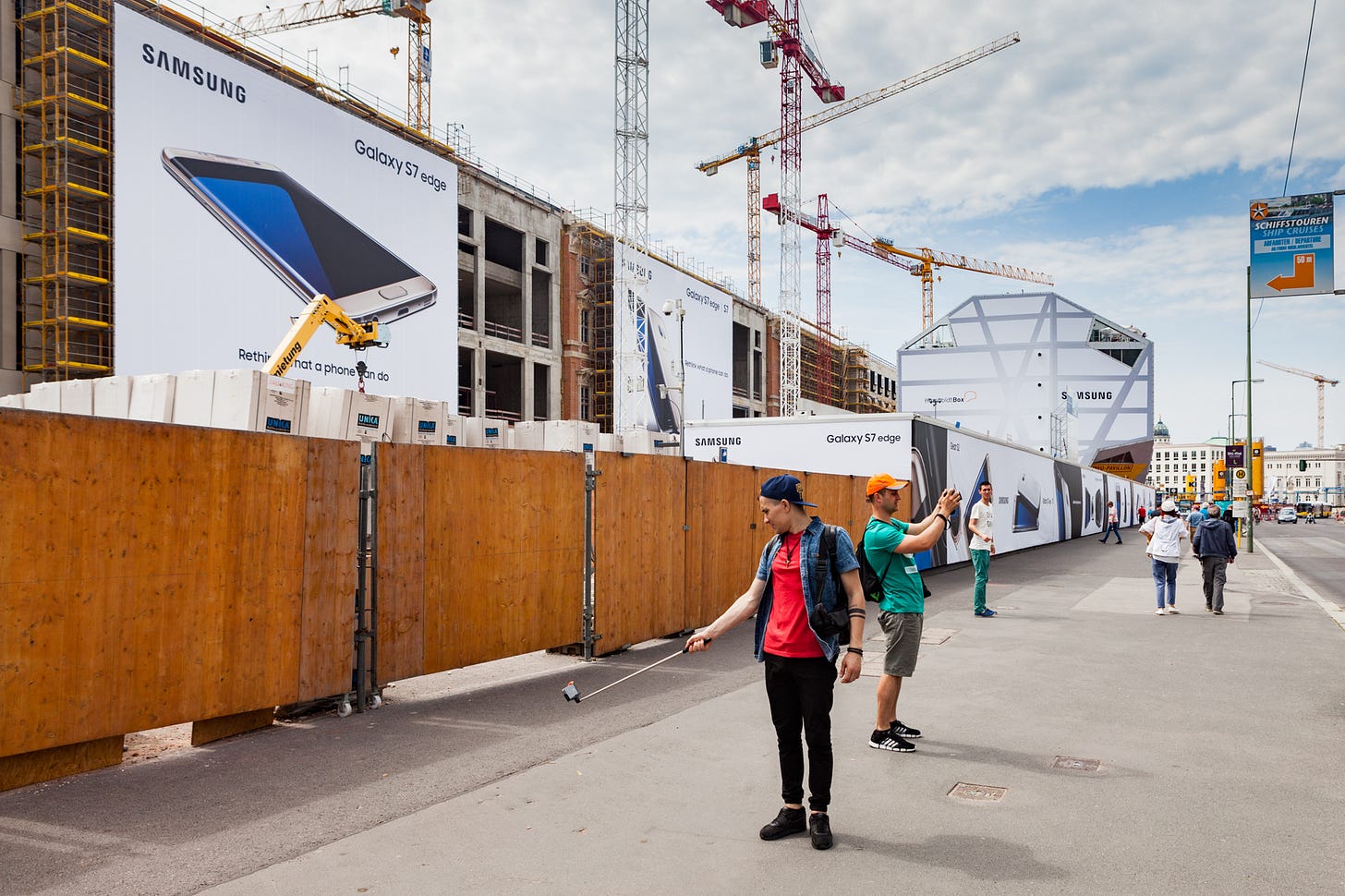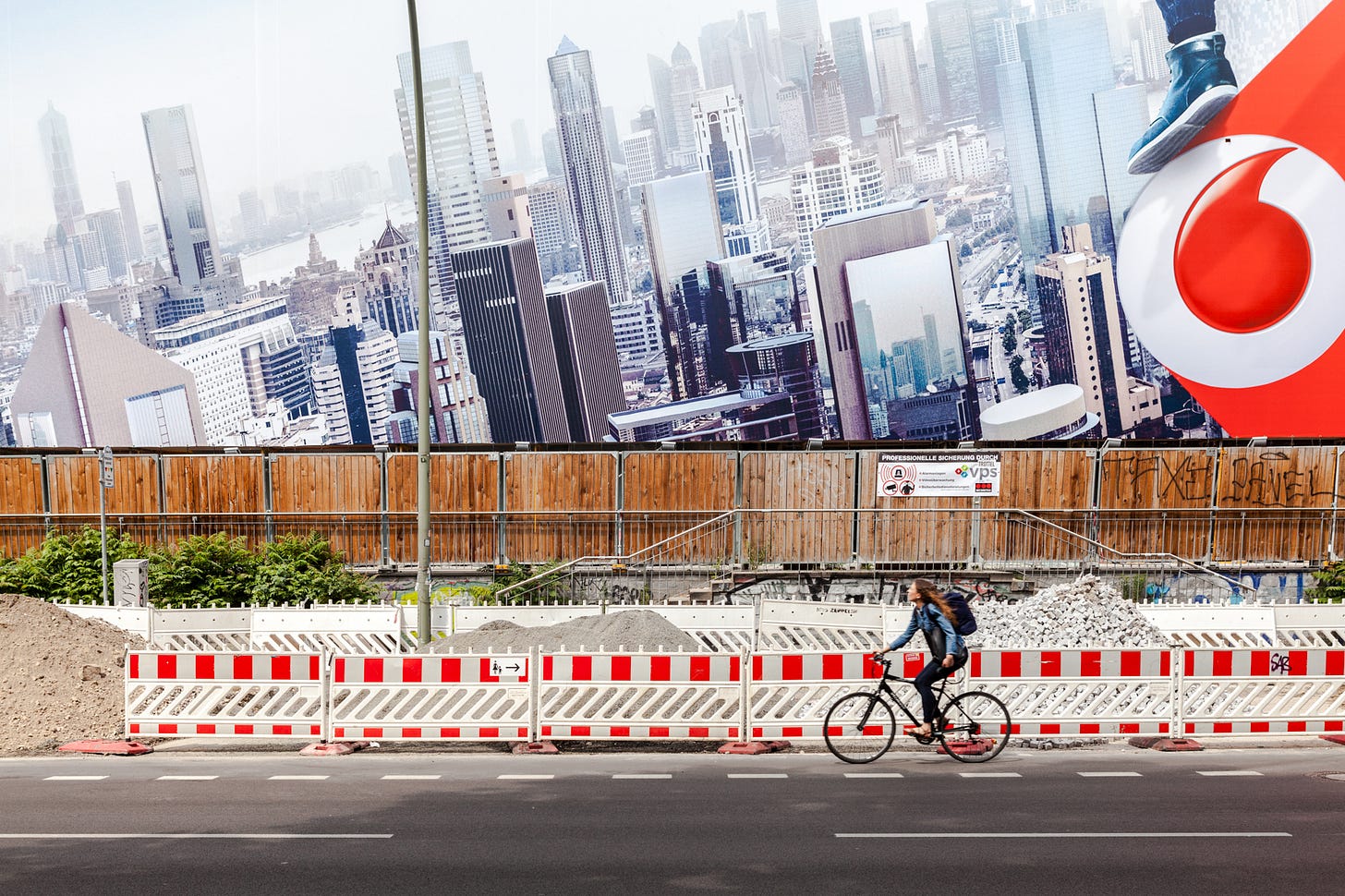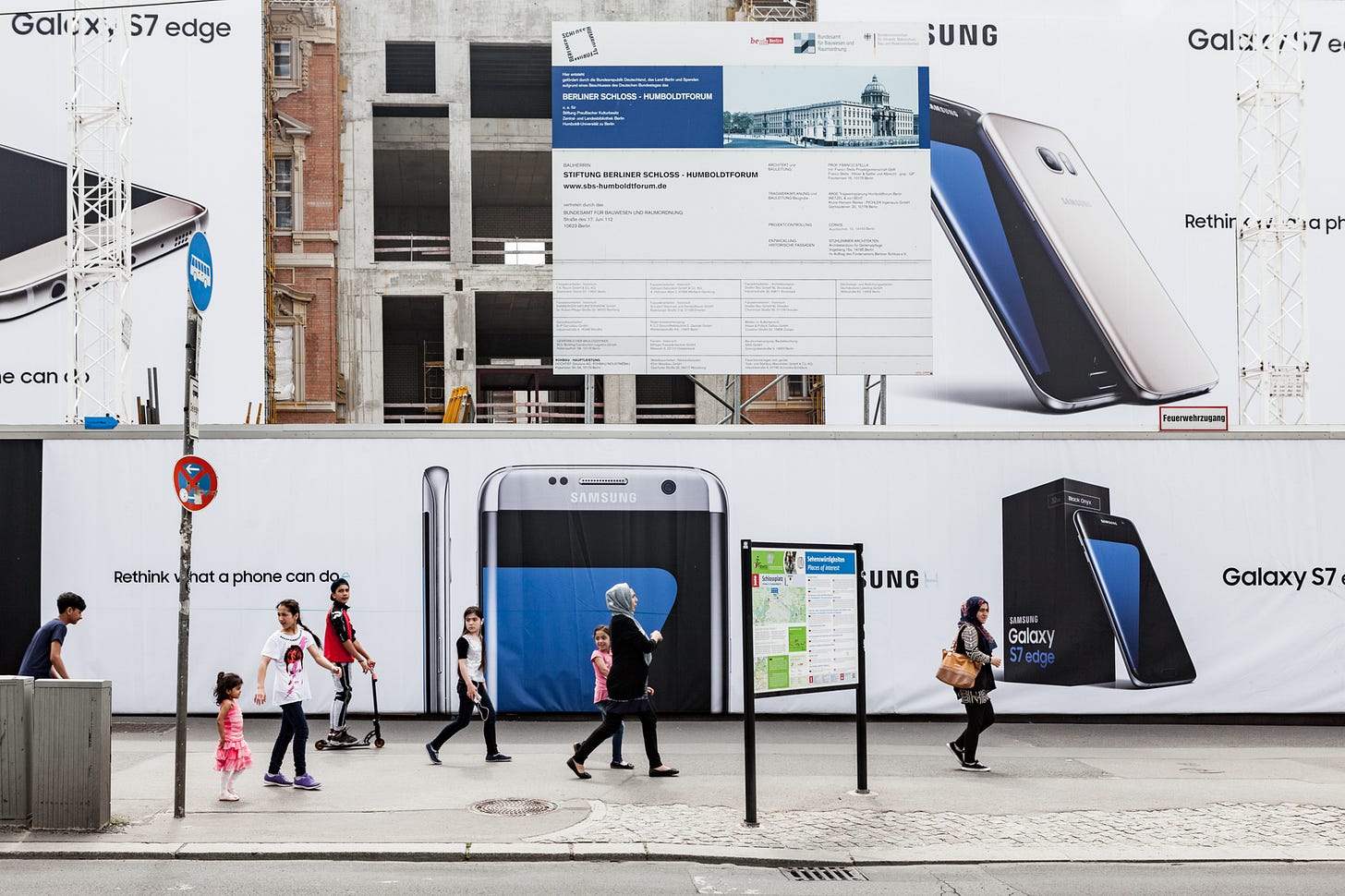Berlin circa 2016 - Photo Manuela Conti
In the course of my explorations and lucubrations, I have found myself reading the transition from the horizontal and circumscribed extension of the ancient and proto-modern city to its subsequent vertical and diffuse, late-modern articulation of the cinematic city, as part of a broader process in three steps. The historical evolution of urbanisation moves from an initial solid state, centred on containment, defence and horizontal expansion, to a liquid state (Baumann docet) characterised by strategic control of flows and nodes, extrusion and visibility, until reaching a third, definitive gaseous state. Here, finally, through the process of digitisation and capillary technological mediation that pervades the planet, the definitive volatilisation of the city form occurs: a nebulisation of the urban condition that, envelops the planet in a vapour of electronic interactions. These states of the urbanisation process do not succeed each other, but layer one on top of the other, substantiating and enabling each other. Solidly rooted in the infrastructuring of the territory through the original, solid horizontal urbanisation of the planet, technological urbiquity spreads from the emergences and extrapolations of vertical urbanism and satellite coverage, realising de facto the idea of planetary urbanisation.
It goes without saying that this condition does not mean that the planet is uniformly covered by - or of - cities; if anything, it means that the life of urban concentrations affects and produces a relevant and unavoidable eco-systemic impact in every remote corner of the globe. In the condition of technological urbiquity, everything that once gave the city its reason to exist as a discrete spatial and administrative entity - markets, resources, knowledge, education, health, participation in cultural communities and communities of interest, social inclusion, worship, entertainment - all become ubiquitously accessible to most, without necessarily taking place within the city, but rather through the city. The ubiquitous condition does not determine that the city disappears as a specific form, but rather that it finds itself grafted and integrated as an essential node of a planetary infosphere, an electronic continuum that significantly transforms its texture, layout, economy, politics and environmental impact. Downtowns and villages, conurbations and suburbs, rural areas and wilderness, all interpenetrate into a sentient and interdependent noosphere.
Berlin circa 2016 - Photo Manuela Conti
Paradoxical effect: while the city becomes no longer strictly necessary to enjoy the benefits that civilised urban life promises, the process of planetary urbanisation, with its pendants of sub-urbanisation and mediatisation, does not seem to alter in the slightest the attractiveness of urban centres for capital, nor the role of cities as places of economic value generation. On the contrary, it intensifies their magnetism, their monetary appeal, and accentuates their capacity to produce inequality and conflict. The concentration of power and wealth is emancipated from the need to substantiate itself in a human environment, welcoming and affordable to the human community of which it would like to be the expression and settlement. New paradoxical models of cities without inhabitants ('posthuman'?) are emerging, such as London, where not even the 'normal rich' can afford to live any more, Berlin, which expels the citizens who regenerated it from the rubble of the (hot and cold) war in a triumph of coolness, Venice and other historical centres which lose residents to welcome temporary city users and drain wealth into platform real-estate, but also the Chinese ghost towns assembled for production needs without a real demand for residence, or the deserted and crumbling Olympic villages or other similar scraps of the global festivalisation.
In the book I am writing, the three phases of planetary urbanisation are retraced in a temporal order, following my personal explorations over some thirty years, with a particular focus on the three cities analysed as case studies in the doctoral thesis I did over twenty years ago. They constitute three sections, named accordingly extension, elevation and evaporation. In this newsletter I will initially follow this path, probably starting to include here and there divagations and bibliographic insights.
The first part of the book is dedicated to the horizontal dimension of the urbanisation process, told in the first person, through a practice of flânerie in public space elevated to a methodological approach. The first chapter in particular, The Invention of Public Space, takes up the certeauian-inspired title of the doctoral thesis from which it stems, and then continues in the next three chapters each dedicated to one of the three cities, Florence, Berlin and New York, and the inspirations I drew from them. Here the focus is mainly on the problematic concept of public space born of modernity, its dissolution in the face of the unsustainability of the public/private dichotomy in the new liberalist order, and the search for its regeneration in social practices and in the third dimension of the common good. The concept of public space constitutive of modernist spatial organisation and planning has, I believe, become unusable, giving way to a fluid process of negotiation between publicness and privacy that is indifferent to the legal nature of a given space, and which mostly takes place through the mediation of corporate infrastructures and state or military apparatuses. As the discourse on public space becomes ubiquitous in recent urban rhetoric, it actually takes on a nostalgic, romanticised evocation form that encourages its fetishisation and commodification.
Berlin circa 2016 - Photo Manuela Conti
The second part, Elevation, investigates the emergence of the cinematic city in its vertical dimension, that is, the articulation of a system of semantic surfaces devoted to what Paul Virilio has called the logistics of perception.1 A natural fulfilment of what we understand as architectural modernity, the processes of spatial and image production have found themselves in urban development and the global economy increasingly intertwined and finally fully integrated. This imbrication between construction and representation determines a new incarnation of the urban form, the product of an incestuous relationship between cinema and the city, which, by promising a hybrid (nowadays 'augmented') dimension of human spatiality enveloped in Promethean aura, realises in effective terms that apparatus of control that Guy Debord had labelled as integrated spectacle. In this transformation, the basic element of the city, the wall, understood essentially as a containing surface, is surpassed by the screen, an enunciating, active surface, endowed with controlled transparency and dedicated to the transmission of information and values. Techniques borrowed from audiovisual production have become central to urban development processes, from city branding to the role of the archistars, from the proliferation of design simulation programmes to the spectacularization of participatory processes; in parallel, entertainment and information technology corporations, up to the explosion of platform capitalism, have become increasingly decisive in defining and controlling urban processes.
But in the acceleration of technological tools and connectivity that expands the expressive capacity of the cinematic city, suddenly there also seems to be the prospect of its overcoming, through a significant disruption of its established centralities. This is why the third part of the book, Evaporation, addresses the process of capillary explosion of communication, with the refractive multiplication of cinematic production through the satellite network, the spread of smartphones and the emergence of the platform economy. As cinema-going as we knew it dies, and cinemas end up transformed into shopping malls, bingo halls and car parks, cinema as a mode of production breaks through all barriers and overflows ubiquitously into everyone's hands and pockets, invades every recess of everyday life through smart screens and wi-fi connections, and establishes a new regime of total and permanent digital connection. If in the vertical city the architectural screens (and consequently the billboard, the shop window, the prestigious location, the vantage point) acquired strategic value, the multiplication of portable micro-screens calls into question the morphology and hierarchical organisation of the urban form. It profoundly changes the way in which we perceive our surroundings, navigate the territory, dialogue and build relationships and communities, while not questioning the attractiveness, symbolic and land value of the city device. Platform urbanism, an urban reflection of platform capitalism, redefines the concepts of planning, investment and urban speculation on the basis of a new gaseous and extremely volatile consistency, in which urban infrastructures act as anchor points.
Berlin circa 2016 - Photo Manuela Conti
If the third part of the book is mainly dedicated to analysing the new user experience of the 21st century citizen and its reflections on how we conceive and practise digital citizenship, in the final chapter I attempt to touch on the weakest and darkest points of global urbanisation, dwelling on the opaque and disguised back-end of submerged infrastructures and extra-statecrafts that, necessary for its existence, elude the gaze of most - that is, out of democratic control. At the same time, such increasingly resource voracious and decision-makingly autonomous infrastructural concentrations make the planetary urban model unsustainable on a social, environmental, and economic level, as recurring and ever-closer systemic crises seem to presage.
Paul Virilio (1989) Ware and Cinema: Logistics of Perception. London: Verso







